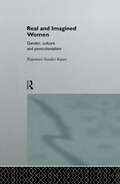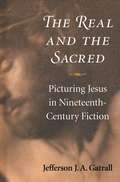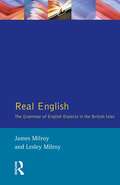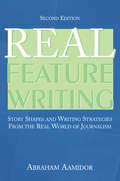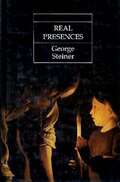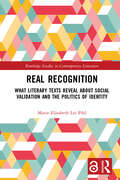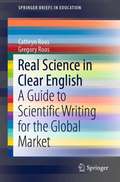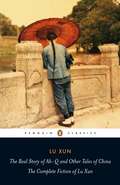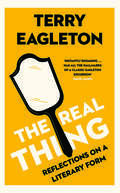- Table View
- List View
Real and Imagined Women: Gender, Culture and Postcolonialism
by Rajeswari Sunder RajanFirst published in 1993. Routledge is an imprint of Taylor & Francis, an informa company.
The Real and the Sacred: Picturing Jesus in Nineteenth-Century Fiction
by Jefferson J GatrallThe figure of Jesus appears as a character in dozens of nineteenth-century novels, including works by Balzac, Flaubert, Dickens, Dostoevsky, and others. The Real and the Sacred focuses in particular on two fiction genres: the Jesus redivivus tale and the Jesus novel. In the former, Christ makes surprise visits to earth, from rural Flanders (Balzac) and Muscovy (Turgenev) to the bustling streets of Paris (Flaubert), Seville (Dostoevsky), Berlin, and Boston. In the latter, the historical Jesus wanders through the picturesque towns and plains of first-century Galilee and Judea, attracting followers and enemies. In short, authors subjected Christ, the second person of the Christian trinity, to the realist norms of secular fiction. Thus the Jesus of nineteenth-century fiction was both situated within a specific time and place, whether ancient or modern, and positioned before the gaze of increasingly daring literary portraitists. The highest artistic challenge for authors was to paint, using mere words, a faithful picture of Jesus in all his humanity. The incongruity of a sacred figure inhabiting secular literary forms nevertheless tested the limits of modern realist style no less than the doctrine of Christ’s divinity. The international “quest of the historical Jesus” has been amply documented within the context of nineteenth-century biblical scholarship. Yet there has been no broad-based comparative study devoted to the depiction of Jesus in prose fiction over the same time period. The Real and the Sacred offers a comprehensive survey of this body of fiction, examining both the range of its Christ types and the varying formal means through which these types were represented. The nineteenth century—despite forecasts of God's death at the time—not only revived older Christ types but also witnessed the rise of new ones, including le Christ proletaire, the Mormon Christ, the Buddhist Christ, and the Tolstoyan Christ. Novelists played a crucial role in the invention and popularization of the historical Jesus in particular, one of modernity's major figures. These pioneering works of fiction, written by authors of diverse religious and national backgrounds, laid the formal groundwork for an enduring fascination with the historical Jesus in later fiction and film, from Mikhail Bulgakov's Master and Margarita to Mel Gibson's The Passion of the Christ. The book is enhanced by a gallery of illustrations of the historical Jesus as depicted by nineteenth-century artists.
The Real Chekhov: An Introduction to Chekhov's Last Plays (Routledge Library Editions: Russian and Soviet Literature #9)
by David MagarshackWhat is Chekhov’s method of ensuring audience participation? What does his stage direction ‘through tears’ mean? What happens between the first and second acts of The Seagull? Is there any reason for the despondency in Chekhov’s drama? This book, first published in 1972, discusses these questions and many other issues around Chekhov’s last four plays. David Magarshack, the leading translator and biography of many of Russia’s greatest writers, closely examines Chekhov’s work for the relevant facts about his writing, and demonstrates that no reliance should be placed on the so-called subtext which can introduce all sorts of irrelevancies arising from pre-conceived ideas about the plays. A careful reading of Chekhov’s text itself is all that is needed to correct the familiar distortions of his characters and themes.
The Real Chekhov: An Introduction to Chekhov's Last Plays (Routledge Library Editions: Russian and Soviet Literature #9)
by David MagarshackWhat is Chekhov’s method of ensuring audience participation? What does his stage direction ‘through tears’ mean? What happens between the first and second acts of The Seagull? Is there any reason for the despondency in Chekhov’s drama? This book, first published in 1972, discusses these questions and many other issues around Chekhov’s last four plays. David Magarshack, the leading translator and biography of many of Russia’s greatest writers, closely examines Chekhov’s work for the relevant facts about his writing, and demonstrates that no reliance should be placed on the so-called subtext which can introduce all sorts of irrelevancies arising from pre-conceived ideas about the plays. A careful reading of Chekhov’s text itself is all that is needed to correct the familiar distortions of his characters and themes.
Real English: The Grammar of English Dialects in the British Isles
by James Milroy Lesley MilroyWhile it is accepted that the pronunciation of English shows wide regional differences, there is a marked tendency to under-estimate the extent of the variation in grammar that exists within the British Isles today. In addressing this problem, Real English brings together the work of a number of experts on the subject to provide a pioneer volume in the field of the grammar of spoken English.
Real English: The Grammar of English Dialects in the British Isles
by James Milroy Lesley MilroyWhile it is accepted that the pronunciation of English shows wide regional differences, there is a marked tendency to under-estimate the extent of the variation in grammar that exists within the British Isles today. In addressing this problem, Real English brings together the work of a number of experts on the subject to provide a pioneer volume in the field of the grammar of spoken English.
Real Feature Writing
by Abraham AamidorReal Feature Writing emphasizes story shape and structure by illustrating several distinct types of feature and non-fiction stories, all drawn from the real world. Author Abraham Aamidor presents a collection of distinct non-deadline story types (profile, trend, focus, advocacy, and more), providing an introduction to each story type, a full-text example, a critical analysis of the example, and clear directions for producing similar stories. In this second edition, Aamidor and his guest contributors (all with real-world journalistic experience) demonstrate in clear, honest language how to write features. New for this edition are:*updated examples of feature writing, integrated throughout the text;*a chapter on ethical journalism, which takes a critical look at propaganda;*a chapter on international perspectives, including coverage of issues in the Middle East;*chapters on research, freelancing, content editing, copyediting, and literary journalism.This text is appropriate for upper-level journalism students, and will be a valuable resource for freelance writers and young working journalists needing guidance on writing features.
Real Feature Writing (Routledge Communication Ser.)
by Abraham AamidorReal Feature Writing emphasizes story shape and structure by illustrating several distinct types of feature and non-fiction stories, all drawn from the real world. Author Abraham Aamidor presents a collection of distinct non-deadline story types (profile, trend, focus, advocacy, and more), providing an introduction to each story type, a full-text example, a critical analysis of the example, and clear directions for producing similar stories. In this second edition, Aamidor and his guest contributors (all with real-world journalistic experience) demonstrate in clear, honest language how to write features. New for this edition are:*updated examples of feature writing, integrated throughout the text;*a chapter on ethical journalism, which takes a critical look at propaganda;*a chapter on international perspectives, including coverage of issues in the Middle East;*chapters on research, freelancing, content editing, copyediting, and literary journalism.This text is appropriate for upper-level journalism students, and will be a valuable resource for freelance writers and young working journalists needing guidance on writing features.
The Real History of Tom Jones
by J. StevensonThe Real History of Tom Jones revivifies historical materials from which Henry Fielding constructed the greatest comic novel of the eighteenth century. This study recovers and explores the contexts necessary to understand Fielding's subtle art, such as the bloody conflict for the throne between Stuarts and Hanoverians, a contradictory class system, game laws that both protected and flouted individual property rights, and a justice system that proclaimed hanging for many crimes but let most criminals go. Drawing on evidence such as the peculiar appearance of eighteenth-century money, the fraudulent autobiography of a gypsy king, and a magical prayer book illustration, the book offers new readings of both Tom Jones and the political and legal landscape of Georgian England.
The Real Peter Pan: The Tragic Life of Michael Llewelyn Davies
by Piers DudgeonHis elder brother Peter may have been more aptly named for the part, but it was Michael, the fourth son of Sylvia and Arthur Llewelyn Davies, who was the original 'little half-and-half' - the half-human, half-supernatural Peter Pan, who hopes never to be compelled to grow up and face life's harsh realities. The playwright struck up a friendship with Michael's three older brothers after he encountered them playing in London's Kensington Gardens, an area that would become the first location for the Neverland of his most enduring work. But soon it was Michael who was 'The One'. Touched by his grandfather George du Maurier's 'sixth sense', Michael lived the fantasy life more intensely than any of them, even participating in a hauntingly accurate prediction of events to come as Peter Pan daring himself to drown in the mermaids' lagoon, fascinated by the prospect of an afterlife. Nightmares and an unnatural terror of water ensued, but no one intervened or thought to stop the obvious root to his subconscious fears. Indeed, when Michael's parents - themselves the inspiration for Mr and Mrs Darling in the play - died one after the other, leaving the brothers orphans and real 'Lost Boys', Barrie's involvement was so entrenched that the enigmatic, and by now very rich, playwright offered himself up as guardian. As the years went by, Michael and Barrie became ever closer, their Neverland transferring to the Highlands and islands of Scotland, where, still driven by the need to write from life, Barrie's other-worldly preoccupations steered their fantasy life afresh. Until one day it seemed to Michael time to break free. A true story of friendship, love and childhood innocence, shot through with joy, but terminated by tragedy, The Real Peter Pan is the moving story of a boy who would never grow up.
Real Presences: Is There Anything In What We Say?
by George SteinerCan there be major dimensions of a poem, a painting, a musical composition created in the absence of God? Or, is God always a real presence in the arts? Steiner passionately argues that a transcendent reality grounds all genuine art and human communication. "A real tour de force. . . . All the virtues of the author's astounding intelligence and compelling rhetoric are evident from the first sentence onward."—Anthony C. Yu, Journal of Religion
The Real Real Thing: The Model in the Mirror of Art
by Wendy SteinerOur era is defined by the model. From Victoria’s Secret and America’s Next Top Model to the snapshots we post on Facebook and Twitter, our culture is fixated on the pose, the state of existing simultaneously as artifice and the real thing. In this bold view of contemporary culture, Wendy Steiner shows us the very meaning of the arts in the process of transformation. Her story begins at the turn of the last century, as the arts abandoned the representation of the world for a heady embrace of the abstract, the surreal, and the self-referential. Today though, this “separate sphere of the aesthetic” is indistinguishable from normal life. Media and images overwhelm us: we gingerly negotiate a real-virtual divide that we suspect no longer exists, craving contact with what J. M. Coetzee has called “the real real thing.” As the World Wide Web renders the lower-case world in ever-higher definition, the reality-based genres of memoir and documentary are displacing fiction, and novels and films are depicting the contemporary condition through model-protagonists who are half-human, half-image. Steiner shows the arts searching out a new ethical potential through this figure: by stressing the independent existence of the model, they welcome in the audience in all its unpredictability, redefining aesthetic experience as a real-world interaction with the promise of empathy, reciprocity, and egalitarian connection. A masterly performance by a penetrating, inquisitive mind, The Real Real Thing is that rarest of books, one whose provocations and inspirations will inspire readers to take a new—and nuanced—look at the world around them.
Real Recognition: What Literary Texts Reveal about Social Validation and the Politics of Identity (Routledge Studies in Contemporary Literature)
by Marie-Elisabeth Lei PihlReal Recognition investigates the complexities of literary and social recognition with the aim of putting a fresh, cross-disciplinary spin on reader identification and social acknowledgment. Engaging with contemporary Danish and Anglophone works on racialization, disability, and gender, Marie-Elisabeth Lei Pihl argues in favor of a close relation between aesthetic appeals to recognition and the political dimensions of literary texts. Moreover, she proposes a framework bent on experience and relations, as opposed to identity and status, for articulating new fruitful understandings of how literary texts call for aesthetic and social recognition. Based on this, she argues that literary texts can make readers get what social validation is about – and thereby help us redefine a key concept in the social sciences.Marie-Elisabeth Lei Pihl earned her PhD in literature and sociology from the University of Southern Denmark in 2020. Currently, she works as a postdoctoral researcher within narrative medicine and literature-based social interventions at the University of Southern Denmark in collaboration with the National Institute of Public Health in Copenhagen.Chapter 3 of this book is available for free in PDF format as Open Access from the individual product page at www.routledge.com. It has been made available under a Creative Commons Attribution-Non Commercial-No Derivatives 4.0 license.
Real Recognition: What Literary Texts Reveal about Social Validation and the Politics of Identity (Routledge Studies in Contemporary Literature)
by Marie-Elisabeth Lei PihlReal Recognition investigates the complexities of literary and social recognition with the aim of putting a fresh, cross-disciplinary spin on reader identification and social acknowledgment. Engaging with contemporary Danish and Anglophone works on racialization, disability, and gender, Marie-Elisabeth Lei Pihl argues in favor of a close relation between aesthetic appeals to recognition and the political dimensions of literary texts. Moreover, she proposes a framework bent on experience and relations, as opposed to identity and status, for articulating new fruitful understandings of how literary texts call for aesthetic and social recognition. Based on this, she argues that literary texts can make readers get what social validation is about – and thereby help us redefine a key concept in the social sciences.Marie-Elisabeth Lei Pihl earned her PhD in literature and sociology from the University of Southern Denmark in 2020. Currently, she works as a postdoctoral researcher within narrative medicine and literature-based social interventions at the University of Southern Denmark in collaboration with the National Institute of Public Health in Copenhagen.Chapter 3 of this book is available for free in PDF format as Open Access from the individual product page at www.routledge.com. It has been made available under a Creative Commons Attribution-Non Commercial-No Derivatives 4.0 license.
Real Science in Clear English: A Guide to Scientific Writing for the Global Market (SpringerBriefs in Education)
by Cathryn Roos Gregory RoosThis book is a timely go-to resource for any professionals wishing to communicate with the growing number of readers whose first language is not English. It highlights the potential language difficulties these readers face, and provides guidelines and tools for overcoming them. The guidelines show how to convey complicated information clearly without affecting the integrity of the subject matter, while the practical ‘before’ and ‘after’ examples clearly illustrate how using these guidelines and improves scientific texts. The book also includes text evaluation tools that allow writers to rapidly assess the readability of their materials. It is based on theory and the authors’ extensive experience in producing highly readable English texts for L2 readers who struggle with materials that were originally prepared for L1 readers.
The Real Story of Ah-Q and Other Tales of China: The Complete Fiction of Lu Xun
by Lu XunLu Xun (Lu Hsun) is arguably the greatest writer of modern China, and is considered by many to be the founder of modern Chinese literature. Lu Xun's stories both indict outdated Chinese traditions and embrace China's cultural richness and individuality. This volume presents brand-new translations by Julia Lovell of all of Lu Xun's stories, including 'The Real Story of Ah-Q', 'Diary of a Madman', 'A Comedy of Ducks', 'The Divorce' and 'A Public Example', among others. With an afterword by Yiyun Li.
Real Talk: Reality Television and Discourse Analysis in Action
by Pilar Garces-Conejos BlitvichThis is the first book to examine the discourse of reality television. Chapters provide rigorous case studies of the discourse practices that characterise a wide range of generic and linguistic/cultural contexts, including dating shows in China and Spain, docudramas in Argentina and New Zealand, and talent shows in the UK and USA.
The Real Thing: Reflections on a Literary Form
by Terry EagletonA clear-sighted and entertaining defence of literary realism, and an account of its key practitioners Realist fiction is one of the most enduring artforms history has ever witnessed. By describing the intricate inner life of its characters, or widening its focus to set their experience in context, it can evoke the reader’s sympathies as few other forms can. Yet it is also by and large a product of the middle classes: boldly individualist and fascinated by money, property, marriage, and inheritance. Can such realism survive in the postmodern age? Acclaimed critic Terry Eagleton explores realism’s complex history, practice, and politics. Spanning several centuries, and including writers such as George Eliot, D. H. Lawrence, and Iris Murdoch, Eagleton offers a witty, entertaining defence of a form which offers both panoramic scope and individual nuance in an increasingly fragmented world.
The Real Thing: The Real Thing; Night And Day; Hapgood; Indian Ink; Arcadia
by Tom StoppardThe play begins with Max and Charlotte, a couple whose marriage seems about to rupture. But nothing one sees on a stage is the real thing, and some things are less real than others. Charlotte is an actress who has been appearing in a play about marriage written by her husband Henry. Max, her leading man, is also married to an actress, Annie. Both marriages are at the point of rupture because Henry and Annie have fallen in love. But is it the real thing?
Real-time Speech and Music Classification by Large Audio Feature Space Extraction (Springer Theses)
by Florian EybenThis book reports on an outstanding thesis that has significantly advanced the state-of-the-art in the automated analysis and classification of speech and music. It defines several standard acoustic parameter sets and describes their implementation in a novel, open-source, audio analysis framework called openSMILE, which has been accepted and intensively used worldwide. The book offers extensive descriptions of key methods for the automatic classification of speech and music signals in real-life conditions and reports on the evaluation of the framework developed and the acoustic parameter sets that were selected. It is not only intended as a manual for openSMILE users, but also and primarily as a guide and source of inspiration for students and scientists involved in the design of speech and music analysis methods that can robustly handle real-life conditions.
Real Voices: On Reading
by Philip DavisPoets, novelists and critics committed to creative thinking join together in this collection of essays to say what serious reading really means to them as individuals. The collection is divided into four sections: George Steiner and George Craig on the act of reading in general; Joseph Brodsky, Les Murray, Douglas Oliver and Hester Jones on reading, poetry and vision; John Bayley, Philip Davis and Gabriel Josipovici on reading and teaching in the universities; Raymond Tallis, Michael Irwin, Josie Billington and Doris Lessing on reading and the novel.
Real-World Media Ethics: Inside the Broadcast and Entertainment Industries
by Philippe PerebinossoffIs it ethical to pass yourself off as black if you are Caucasian, as Rachel Dolezai, the president of a local chapter of the NAACP, did in 2015? Was it ethical for Donald Sterling, the former owner of the NBA team, to use racially inflammatory language? Is it ethical to exaggerate or fabricate the importance of one’s role, as Brian Williams apparently did when he anchored the NBC nightly news? Is it ethical for a journalist to pay a source for a story, tips, and photos, as TMZ, Gawker and others do regularly? The above questions as well as other questions definitely illustrate the need for studying ethics. Real-World Media Ethics provides a wide showcase of real ethical issues faced by professionals in the media field. Numerous case studies allow readers to explore multiple perspectives while using realistic ethical principles. This book includes the basics in ethical journalism, as well as the tools to navigate through the landscape of mass media such as public relations, entertainment and other forms of visual communication. The second edition has been updated to encompass globalization, new media platforms, current copyright issues, net neutrality, sports ethics, and more. An accompanying companion website provides additional interviews demonstrating ethical principles in practice. Being a former ABC executive, author Philippe Perebinossoff gives readers an inside look at circumstances with an ethical, experienced eye.
Real-World Media Ethics: Inside the Broadcast and Entertainment Industries
by Philippe PerebinossoffIs it ethical to pass yourself off as black if you are Caucasian, as Rachel Dolezai, the president of a local chapter of the NAACP, did in 2015? Was it ethical for Donald Sterling, the former owner of the NBA team, to use racially inflammatory language? Is it ethical to exaggerate or fabricate the importance of one’s role, as Brian Williams apparently did when he anchored the NBC nightly news? Is it ethical for a journalist to pay a source for a story, tips, and photos, as TMZ, Gawker and others do regularly? The above questions as well as other questions definitely illustrate the need for studying ethics. Real-World Media Ethics provides a wide showcase of real ethical issues faced by professionals in the media field. Numerous case studies allow readers to explore multiple perspectives while using realistic ethical principles. This book includes the basics in ethical journalism, as well as the tools to navigate through the landscape of mass media such as public relations, entertainment and other forms of visual communication. The second edition has been updated to encompass globalization, new media platforms, current copyright issues, net neutrality, sports ethics, and more. An accompanying companion website provides additional interviews demonstrating ethical principles in practice. Being a former ABC executive, author Philippe Perebinossoff gives readers an inside look at circumstances with an ethical, experienced eye.
Realising Linguistic, Cultural and Educational Rights Through Non-Territorial Autonomy
by David J. Smith Ivan Dodovski Flavia GhenceaThis volume assesses Non-Territorial Autonomy (NTA) in terms of its practical capacity to support the linguistic, cultural, and educational rights of national minority groups across Europe. The fact that 2023 marks the 25th anniversary of the coming into force of the Council of Europe Framework Convention on National Minorities (FCNM) and European Charter for Regional and Minority languages (ECRML) makes this book especially timely and relevant. Its numerous detailed empirical studies, one of which uses FCNM reporting as a benchmark, give a picture of the extent (or otherwise) to which international minority rights standards are actually being realized through various NTA arrangements. In keeping with the principles laid out in these foundational documents, the contributions to this volume acknowledge that when it comes to the effective delivery of linguistic, cultural and educational rights, NTA is best regarded not as an alternative but as a complement toterritorially based arrangements.This is an open access book.
Realism: Aesthetics, Experiments, Politics
by Jens ElzeRealism seems to be everywhere, both as a trending critical term and as a revitalized aesthetic practice. This volume brings together for the first time three aspects that are pertinent for a proper understanding of realism: its 19th-century aesthetics committed to making reality into an object of serious art; the experiments with and against realism by 20th-century modernist, postmodernist, or magical realist writing; and the politics of realism, especially its ambitions to map the complex realities produced by global capitalism and climate catastrophe. This juxtaposition of aesthetics, experiments, and politics unsettles the entrenched opposition between realism and experimental literature that tends to ignore the fact that realism, by virtue of its commitment to a changing material and social world, cannot be but continuously experimenting.The innovative chapters of this book address some of the pressing questions of literary and cultural studies today, like the complex relation between historical materialism and new materialisms, between science and art, or the different aesthetic and political affordances of making systemic analyses against depicting the specificity of the local. Some of the chapters deal with classically realist authors, such as George Eliot, Émile Zola, and Joseph Conrad, to gauge the aesthetic radicalism of their diverse realist projects. Others investigate the experimental engagements with realism by authors such as B.S. Johnson, J.M. Coetzee, or Rachel Cusk. Yet others, analyze the politics of realism found in contemporary anglophone novels by writers like Chimamanda Ngozi Adichie, David Mitchell, or Rohinton Mistry. The readings assembled here are a testament to the diversity of literary realism(s) from the 19th, 20th, and 21st centuries, and to the ongoing controversies surrounding definitions and deployments of “realism.”
